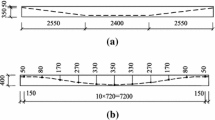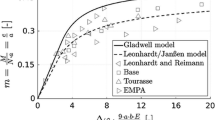Abstract
A long-term deflection test is performed for 470 days on two simply supported prestressed concrete box beams under sustained uniform load. The deflection growth rules of the box beams under both cracked and uncracked states are studied. The measured longterm deflection of the cracked beam is 18.4% larger than that of the uncracked beam, whereas the deflection growth coefficient of the cracked beam is 65.3% that of the uncracked beam. The larger long-term deflection of the cracked beam is mainly attributed to the huge value of the instantaneous deflection caused by the crack. Then, the cracks lead to the release of concrete stress, thereby reducing the creep effect. For the uncracked beam, the influences of concrete shrinkage, creep, and prestress loss on the long-term mechanical behavior of components are considered, and then deflection is predicted using the blended method based on the age-adjusted modulus method, the prestressed equivalent load method, and the calculation method for prestress loss. Results show that the theoretical and measured values are in good agreement. For the cracked beam, the crack influence coefficient is introduced to revise its effective elastic modulus by considering the influence of cracks on the long-term deflection of the cracked beam. Then, a formula for calculating the long-term deflection of cracked beams that considers stiffness reduction for instantaneous deflection correction is proposed. The formula exhibits high precision in calculating and analyzing the long-term deflection of the cracked beam. The deviation between the calculated and measured values is within 10%.
Similar content being viewed by others
References
ACI 209R-92 (1997). Prediction of Creep, Shrinkage and Temperature Effect in Concrete Structures, ACI Manual of Concrete Practice-Part, American Concrete Institute, pp. 4-12.
ACI Committee 318-08 (2008). “Building code requirements for structural concrete and commentary.” American Concrete Institute, Farmington Hills, USA.
Au, F. T. K., Cheng, Y. S., and Cheung, Y. K. (2001). “Effects of random road surface roughness and long-term deflection of prestressed concrete girder and cable-stayed bridges on impact due to moving vehicles.” Computers & Structures, Vol. 79, No. 8, pp. 853–872, DOI: 10.1016/S0045-7949(00)00180-2.
Bacinskas, D., Kaklauskas, G., Gribniak, V., Sung, W. P., and Shih, M. H. (2012). “Layer model for long-Term deflection analysis of cracked reinforced concrete bending members.” Mechanics of Time-Dependent Materials, Vol. 16, No. 2, pp. 117–127, DOI: 10.1007/s11043-011-9138-9.
Bischoff, P. H. (2005). “Reevaluation of deflection prediction for concrete beams reinforced with steel and fiber reinforced polymer bars.” Journal of Structural Engineering, Vol. 131, No. 5, pp. 752–767, DOI: 10.1061/(ASCE)0733-9445(2005)131:5(752).
Cao, G. H. and Fang, Z. (2009). “Long-term behavior analysis of concrete continuous box girder.” Engineering Mechanic, Vol. 26, No. 3, pp. 155–160.
CEB-FIP Model Code 1990 (1993). Model Code for Concrete Structures, Comité Euro-International du Béton, Thomas Telford, pp. 51-58.
Cen. Eurocode 2 (2004). “Design of concrete structures, General rules and rules for buildings.” European Committee for Standardisation, Brussels, BEL.
Fan, J. S., Nie, J. G., and Li, Q. (2009). “Long-term behavior of composite beams under positive and negative bending. I: experimental study.” Journal of structural engineering, Vol. 136, No. 7, pp. 849–857, DOI: 10.1061/(ASCE)ST.1943-541X.0000175.
Fan, J. S., Nie, J. G., and Li, Q. (2009). “Long-term behavior of composite beams under positive and negative bending. II: Analytical study.” Journal of structural engineering, Vol. 136, No. 7, pp. 858–865, DOI: 10.1061/(ASCE)ST.1943-541X.0000176.
Gilbert, R. I. (1999). “Deflection calculation for reinforced concrete structures-Why we sometimes get it wrong.” ACI structural journal, Vol. 96, No. 6, pp. 1027–1033.
Gribniak, V., Bacinskas, D., Kacianauskas, R., Kaklauskas, G., and Torres, L. (2013). “Long-term deflections of reinforced concrete elements: Accuracy analysis of predictions by different methods.” Mechanics of Time-Dependent Materials, Vol. 17, No. 3, pp. 297–313, DOI: 10.1007/s11043-012-9184-y.
Gribniak, V., Kaklauskas, G., Torres, L., Daniunas, A., Timinskas, E., and Gudonis, E. (2013). “Comparative analysis of deformations and tensionstiffening in concrete beams reinforced with GFRP or steel bars and fibers.” Composites Part B Engineering, Vol. 50, No. 50, pp. 158–170, DOI: 10.1016/j.compositesb.2013.02.003.
Jin, C. D. (1981). “Analysis of deformation and stress redistribution of continuous structure due to creep of concrete——taking account of loading at different age and delayed elasticity of concrete.” China Civil Engineering Journal, Vol. 3, No. 8, pp. 19–33.
JTG D62-2004 (2004). “Code for design of highway reinforced concrete and prestressed, concrete bridges and culverts.” Ministry of transport of the People’s Republic of China, Beijing, PRC.
Marí, A. R., Bairán, J. M., and Duarte, N. (2010). “Long-term deflections in cracked reinforced concrete flexural members.” Engineering Structures, Vol. 32, No. 3, pp. 829–842, DOI: 10.1016/j.engstruct.2009.12.009.
Marí, A. R., Oller, E., Bairán, J. M., and Duarte, N. (2013). “Simplified method for the calculation of long-term deflections in FRP-strengthened reinforced concrete beams.” Composites Part B: Engineering, Vol. 45, No. 1, pp. 1368–1376, DOI: 10.1016/j.compositesb.2012.07.003.
Park, H. G., Hwang, H. J., Hong, G. H., Kim, Y. N., and Kim, J. Y. (2012). “Immediate and long-term delections of reinforced concrete slabs affected by early-age loading and low temperature.” ACI Structural Journal, Vol. 109, No. 3, pp. 413–422, DOI: 10.14359/51683755.
Peter, F. Takcics (2002). “Deformations in concrete cantilever bridges observations and theoretical modeling.” Norway: The Norwegian University of Science and Technology.
Robertson, I. N. (2005). “Prediction of vertical deflections for a long-span prestressed concrete bridge structure.” Engineering Structures, Vol. 27, No. 12, pp. 1820–1827, DOI: 10.1016/j.engstruct.2005.05.013.
Rodriguez, S. (2004). “Design of long span concrete box girder bridges: Challenges and solutions.” Proc., 2004 Structural Engineering Institute, ASCE, pp. 1–11, DOI: 10.1061/40700(2004)40.
Sun, H. L., Ye, L. P., and Feng, P. (2007). “Long-term deflection prediction of reinforced concrete beams.” Engineering Mechanics, Vol. 24, No. 11, pp. 88–92.
Torres, L., Miàs, C., Turon, A., and Baena, M. (2012). “A rational method to predict long-term deflections of FRP reinforced concrete members.” Engineering Structures, Vol. 40, No. 7, pp. 230–239, DOI: 10.1016/j.engstruct.2012.02.021.
Tröst, H. (1967). “Auswirkungen des Superpositionsprinzips auf Kriech-und Relaxationsprobleme bei Beton und Spannbeton.” Beton-und Stahlbetonbau, 1967, Vol. 62, No. 10, pp. 230–238.
Xie, J., Wang, G. L., and Zheng, X. H. (2007). “Review of study of long-term deflection for long span prestressed concrete box-girder bridge.” Journal of Highway & Transportation Research & Development, Vol. 2, No. 2, pp. 47–51, DOI: 10.1061/JHTRCQ.0000194.
Yang, I. H. (2003). “Probabilistic analysis of creep and shrinkage effects in PSC box girder bridges.” KSCE Journal of Civil Engineering, 2003, Vol. 7, No. 3, pp. 275–284, DOI: 10.1007/BF02831778.
Zhou, W. Z. and Kokai, T. K. (2010). “Deflection calculation and control for reinforced concrete flexural members.” Canadian Journal of Civil Engineering, Vol. 37, No. 1, pp. 131–134, DOI: 10.1139/L09-121.
Author information
Authors and Affiliations
Corresponding author
Rights and permissions
About this article
Cite this article
Cao, G.H., Zhang, S., Zhang, W. et al. Long-term deflection test and theoretical analysis on cracked prestressed concrete box beams. KSCE J Civ Eng 22, 688–695 (2018). https://doi.org/10.1007/s12205-017-1295-1
Received:
Accepted:
Published:
Issue Date:
DOI: https://doi.org/10.1007/s12205-017-1295-1




